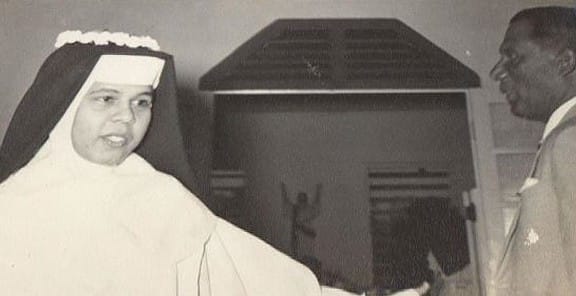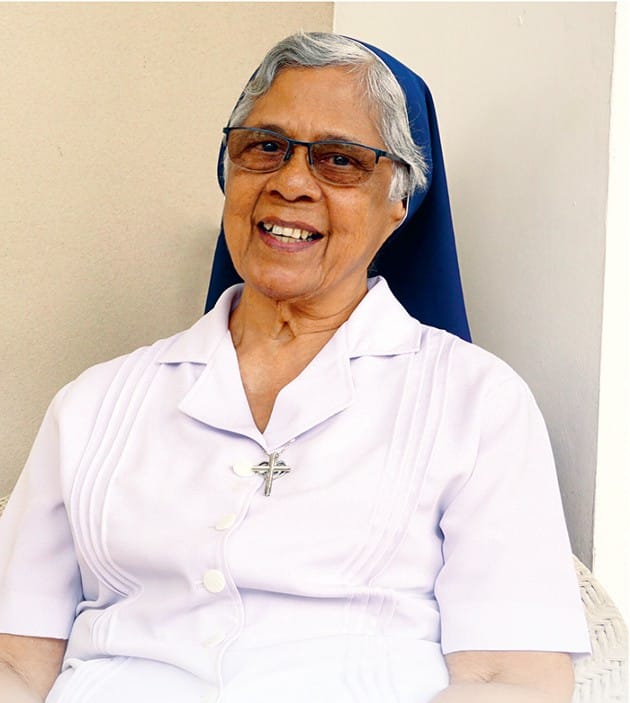Hold My Hand Till the End: An Interview with Sister Gerard Fernandez
After the trials have ended and the death sentence passed, what happens to prisoners on death row? In an oral history interview, Sister Gerard Fernandez sheds light on the final days of some of Singapore’s most famous death row inmates.

BY FOO KIM LENG
Amazing Grace is one of the most popular hymns around Changi Prison’s death row. It is sung joyfully — sometimes in Mandarin and Malay — by prisoners on death row to lift the spirits of one who is walking to the hanging chambers.
It was a particular favourite of Flor Contemplacion and Van Tuong Nguyen, who both requested for it to be sung when they were executed for murder and drug trafficking, respectively. It was the same hymn that was sung when Adrian Lim, one of Singapore’s most notorious murderers made his confession to the priest in the final week of his life.
“I SANG BEAUTIFULLY AT THAT TIME. MY VOICE IS GOING NOW…”
One voice heard in common during all three occasions was that of Sister Gerard Fernandez. But she didn’t just sing; as the founder of the Roman Roman Catholic Prison Ministry, she has prayed with and counselled more than a dozen prisoners on death row.
One of these prisoners shot to notoriety in 1981. That year, Singapore was shocked by the horrific murders of two young children — Agnes Ng and Ghazali Marzuki — and the bizarre practices by Adrian Lim and his mistresses Catherine Tan and Ho Kah Hong.
Sister Gerard knew three of the involved personally: Adrian, Catherine and Agnes. She recalls, “I was very much a part of their lives.” Adrian had been a warden in her parish in the Church of the Risen Christ in Toa Payoh, while Agnes’ sister was a cook in the church and Catherine was her pupil.
“I thought they would hang [Catherine] the day the trial was over. I wrote to the Director of Prisons and asked to see her.” Sister Gerard waited for more than six months before receiving a letter signed by ‘Your black sheep Catherine’. That led the then-36-year old nun to help those on death row through the Roman Catholic Prison Ministry that she formed.
In the 40 years since, Sister Fernandez has made countless trips to Changi Prison, speaking to other famous names in Singapore’s legal history. But these stories were hidden away for much of this time and were revealed only last year, when Sister Gerard agreed to a two-hour oral history interview with SAL. It was then that she explained why she often upheld the “sacred trust” between nun and confessor all this while.
Keeping mum and staying away from the limelight had not been easy, given the profiles of those she helped. For 35 years, journalist Alan John repeatedly requested for an interview; however, it was only recently that she finally opened up for him to complete the second edition of his book The Unholy Trinity about the Adrian Lim murders.
Her greatest satisfaction came from seeing the peace and acceptance experienced by those whom she had counselled. “The hardest part is when it [clemency] is rejected. … they have to enter into that pain and that’s not easy for them…[but] once they had accepted this is going to happen to me, then there is a certain peace that comes. And I think that’s because there’s counselling, rehabilitation, there’s a readiness to accept and that makes a world of difference.”
An unexpected twist of fate brought Sister Gerard to help the man who prosecuted and pushed for the death sentence on Adrian, Catherine and Ho. Mr Glenn Knight was a rising star in the Attorney-General’s Chambers and Sister Gerard remembered often seeing him at Changi Prison. She would later tell him, “You would be standing beside me and you wouldn’t even look at me. You’d sign the book and you’d go off.”
But Sister Gerard saw a very different side of the man a few years later in the early 1990s, when his legal troubles began. At that point, he turned to Sister Gerard for solace and comfort, sparking a friendship that continues till today. “When the case started, Susan Jacob, his good friend … they wanted prayers, wanted peace of mind and heart,” she remembers. “So she came to me and I was surprised. I didn’t expect this… And when she brought him to me that very first day to Marymount, he was really a sad, devastated man. My heart went out to him.”
“And on the last day of the trial, when he would be sentenced… You know I was thinking, poor Glenn, he had sent many to prison … Oh dear, if he goes to prison, it would be terrible, I don’t know what would happen to him. I prayed a lot, dear Lord please just work this out for him.” When Mr Knight was eventually sentenced to a day in prison and a fine, she heaved a sigh of relief. “He was able to pay that and stay one day … that I felt was a real answer to prayer.”

Excerpts from the interview:
Life on death row:
o “That place is like a community… from their cells, they give support to each other. They were all singing and praying together.”
o “Every day they can go to the yard… they have exercise. There is a set time but the officers are very understanding and they even have the cooks that cook the food for them that they can eat. They have a TV that they can watch… And after a while, they spent more time in prayer than watching the TV… They have a mat that they sleep on, then there’s a little toilet.”
Preparing for death:
o They are told on Tuesday, then they are able to see [their family members] every day… right up to Thursday evening [and] Friday morning.
o The night before: “I usually with the priests, would spend the night…with them. So some of them would be writing letters, last minute things and then we would pray together.
o “About five o’clock they take a bath, they dress themselves up and they get ready. Every prisoner is asked what would you like for your last meal. But I don’t think the girls [Catherine and Ho] were so interested in their last meal. They were more filled with this conviction, “I am saved, I am going to God.”
Walking to the gallows: “I walk with them to the trap door. Normally they are handcuffed at the back so that they don’t struggle and usually they allow me to put the rosary in their hands…” “I kneel down and when I hear the lever, I know that she’s gone. I sense [it]. It’s kind of a mystery that you know someone you were just walking with is just gone like that. And so peacefully, no struggle. If they struggle, then it’s not instant death.”
After the hanging: “In those days, they used to have to keep the body hanging for about half an hour before the coroner’s inquest. So we used to wait… And then they would let me come in. And because I promised them to would close their eyes in death, they are brought down and laid on a stretcher…They were not gruesome looking. They were not frightening. I knelt beside them, their eyes were already closed, their tongues a little bit sticking out, not ugly-looking. Their hands were put in front and I put the rosary in their hands and there’s just peace. Peace on my side and peace on theirs.”
Listen to Sister Gerard Fernandez’s interview here. Mr Glenn Knight has also been interviewed under our oral history programme. His interview is available here. The Development of The Singapore Legal System is a joint oral history project by SAL’s Legal Heritage Committee and the Oral History Centre, National Archives of Singapore.

